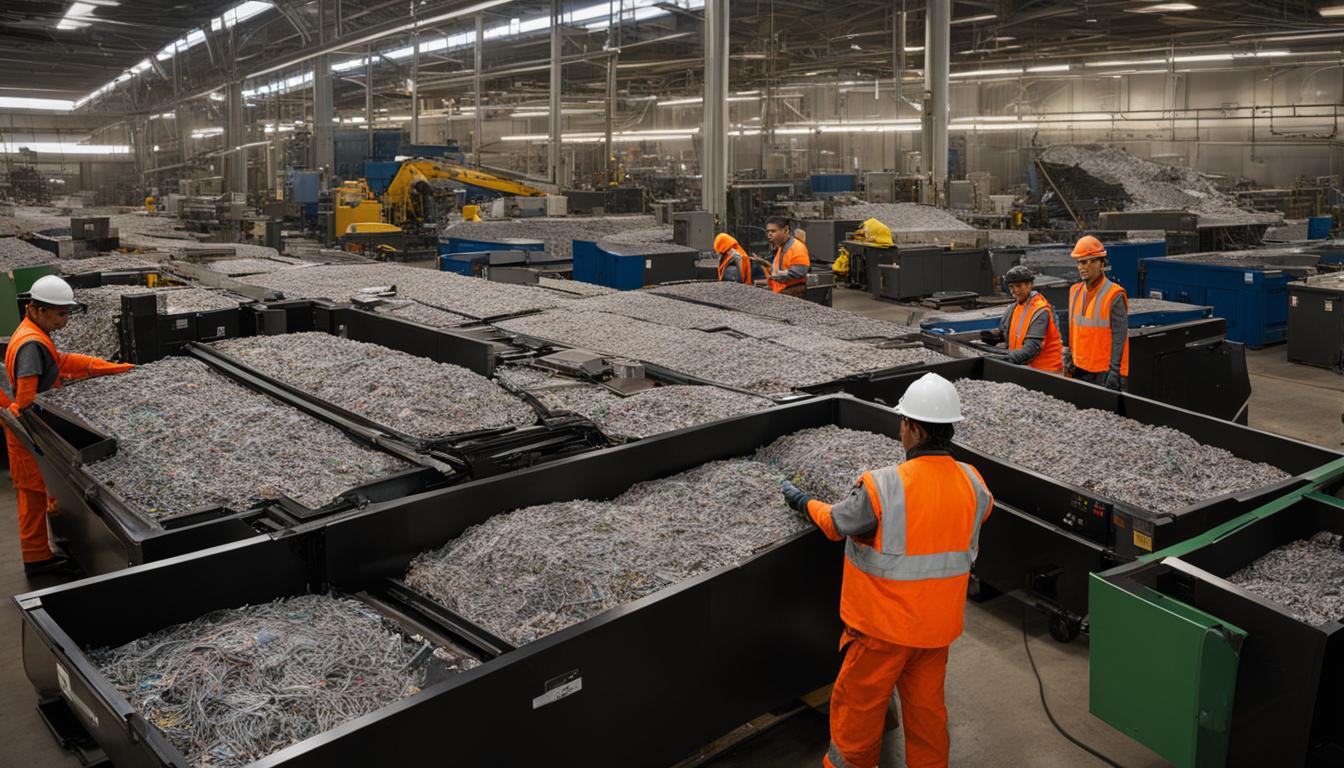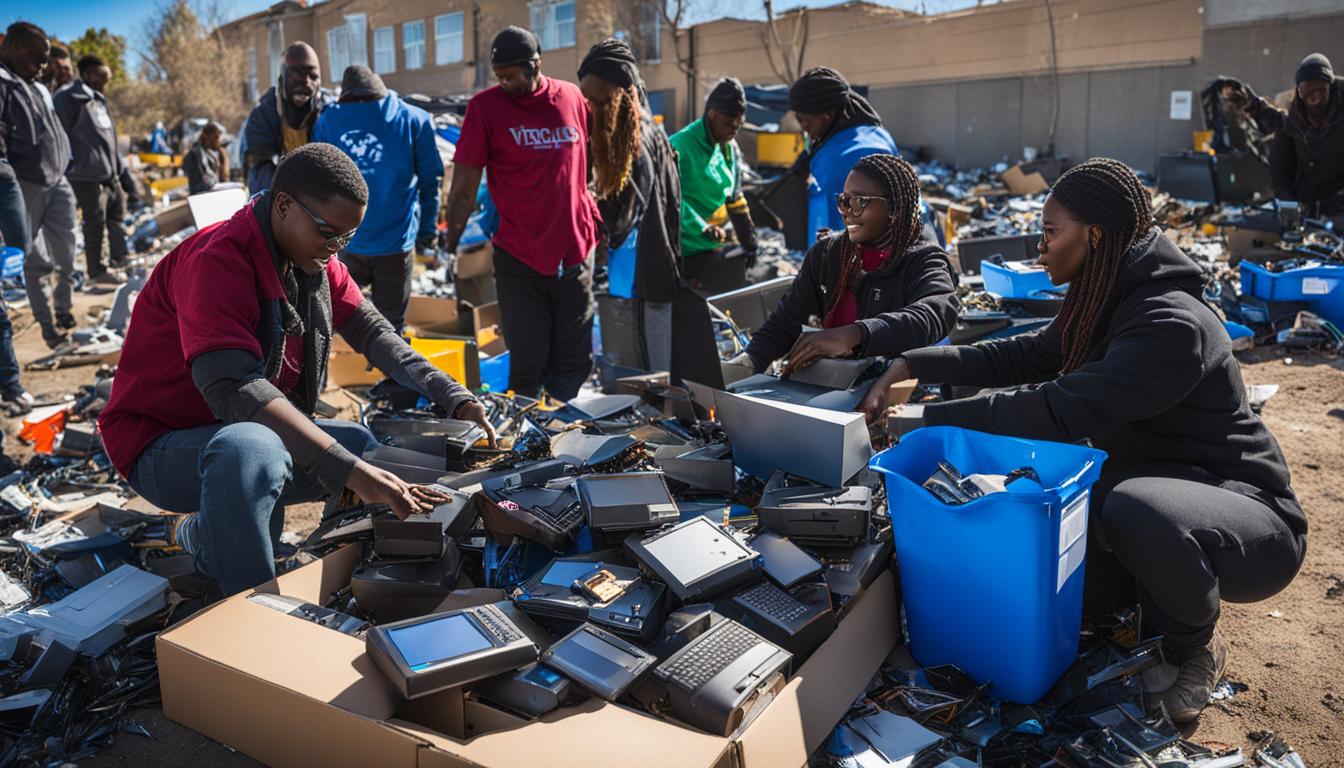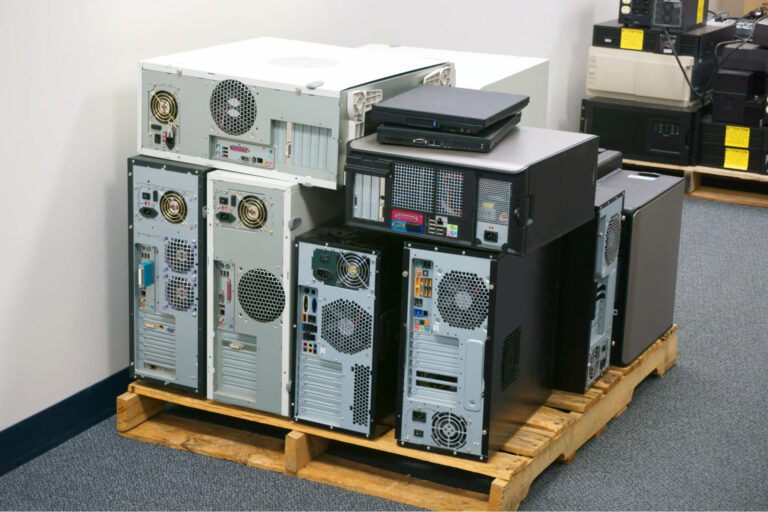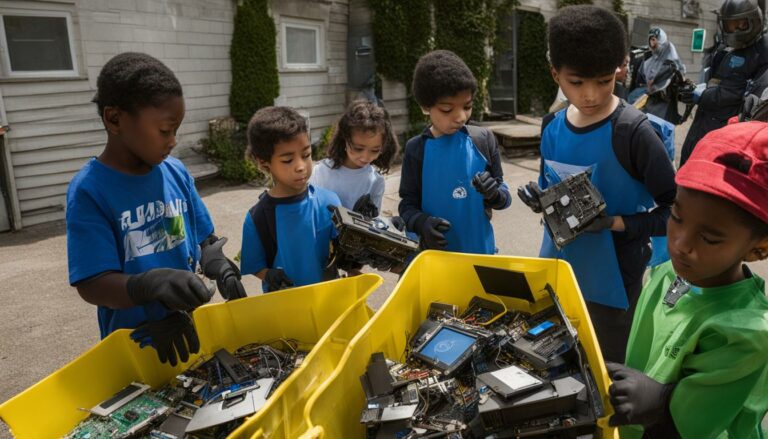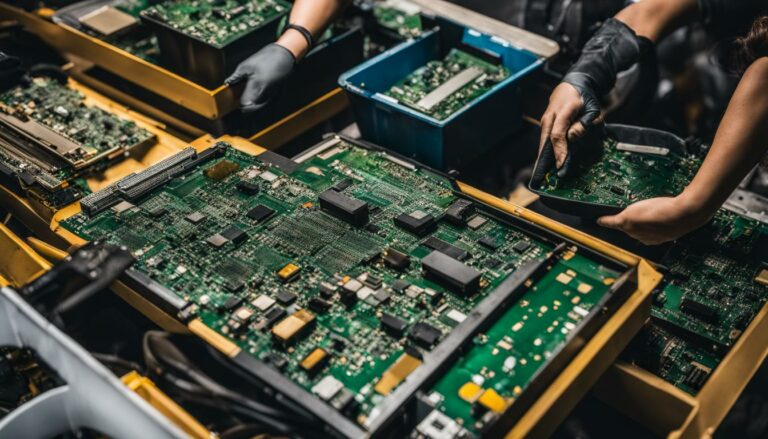An Insider’s Look at IT Recycling Operations
IT recycling operations play a crucial role in managing electronic waste and ensuring responsible disposal of IT equipment. As the volume of electronic waste continues to rise, proper management becomes increasingly important for safeguarding the environment and preventing pollution. This article provides an insider’s look at the processes and strategies involved in IT recycling operations, including electronic waste management and computer recycling services.
Key Takeaways
- IT recycling operations are essential for managing electronic waste and protecting the environment.
- Eco-friendly disposal methods such as IT asset disposition and electronics recycling are prioritized.
- Data security is a significant concern in IT recycling operations, with a focus on secure data destruction.
- IT recycling operations offer multiple benefits, including reducing the carbon footprint and creating job opportunities.
- Challenges include the need for adequate infrastructure, compliance with regulations, and evolving disposal methods.
Eco-friendly Disposal Methods for IT Equipment
Sustainable IT solutions are crucial in the field of IT recycling operations. To ensure responsible e-waste management, companies focus on using eco-friendly disposal methods for IT equipment. This includes IT asset disposition and recycling electronics, which aim to recover valuable materials and reduce the need for resource extraction.
Responsible e-waste management involves proper sorting, dismantling, and recycling processes that minimize the environmental impact of IT equipment disposal. By adopting these methods, IT recycling operations contribute to a more sustainable approach to technology.
Table: Benefits of Eco-friendly Disposal Methods
| Benefits | Description |
|---|---|
| Resource Conservation | By recycling IT equipment, valuable materials such as metals and plastics can be recovered and reused, reducing the demand for new resource extraction. |
| Environmental Protection | Proper disposal methods prevent harmful substances from IT equipment, such as lead and mercury, from polluting the soil and water. |
| Energy Savings | Recycling electronics requires less energy compared to the production of new IT equipment, leading to energy savings and reduced greenhouse gas emissions. |
| Job Creation | IT recycling operations create job opportunities in the field of e-waste management, contributing to economic growth and employment. |
Quote: “The adoption of eco-friendly disposal methods in IT recycling operations leads to a more sustainable approach to technology and environmental protection.” – Environmental Researcher
Data Security in IT Recycling Operations
In addition to environmental concerns, data security is a key priority in IT recycling operations. The secure destruction of data ensures that sensitive information stored on old IT equipment is protected. To achieve this, proper data erasure or physical destruction methods are employed to make the data irrecoverable.
Compliance with data protection regulations is crucial in IT recycling operations. Adhering to these regulations ensures that customer information remains confidential and instills trust in the process. It also helps organizations avoid legal repercussions and maintain their reputation.
Methods of Secure Data Destruction
There are several methods commonly used for secure data destruction:
- Data wiping: This method involves overwriting the existing data on the storage device with random characters, making it virtually impossible to recover the original information.
- Physical destruction: Physical destruction ensures that the data storage device is physically damaged beyond repair. Methods include shredding, crushing, or disassembling the device.
Organizations may choose the appropriate method based on factors such as the type of equipment, the sensitivity of the data, and the level of security required.

The Importance of Secure Data Destruction
“Proper data destruction in IT recycling operations is crucial to safeguard sensitive information and maintain compliance with data protection regulations.”
Secure data destruction is essential for several reasons:
- Protecting sensitive information: Data breaches can lead to significant financial and reputational damage. By securely destroying data, organizations reduce the risk of confidential information falling into the wrong hands.
- Compliance with regulations: Data protection laws, such as the General Data Protection Regulation (GDPR), mandate the secure handling of personal data. Proper data destruction ensures compliance with these regulations.
- Maintaining customer trust: Customers expect their personal information to be handled responsibly. By prioritizing secure data destruction, organizations demonstrate their commitment to protecting customer privacy.
The Benefits of IT Recycling Operations
IT recycling operations offer numerous benefits. By implementing sustainable IT solutions, organizations can reduce their carbon footprint and contribute to a more environmentally friendly approach to technology. Recycling old IT equipment also helps conserve valuable resources and reduces the demand for new production. Additionally, IT recycling operations create job opportunities and support the circular economy by extending the lifespan of IT equipment through refurbishment and resale.
One of the key benefits of IT recycling operations is the reduction of electronic waste. As technology continues to advance at a rapid pace, the amount of discarded IT equipment is also increasing. By recycling old IT equipment, valuable components and materials can be recovered and reused, reducing the need for new resource extraction. This not only conserves natural resources but also helps to minimize the environmental impact associated with the extraction and production of new IT equipment.
Furthermore, IT recycling operations contribute to the creation of a more sustainable future. By promoting the reuse and refurbishment of IT equipment, these operations help to extend the lifespan of devices, reducing the overall consumption of resources. This approach aligns with the principles of the circular economy, which aims to keep products and materials in use for as long as possible, maximizing their value and minimizing waste. By adopting sustainable IT solutions, organizations can play a crucial role in driving this transition towards a more resource-efficient and environmentally friendly approach to technology.
Economic and Social Benefits
In addition to the environmental benefits, IT recycling operations also have economic and social advantages. The recycling industry creates job opportunities throughout the supply chain, from collection and sorting to refurbishment and resale. As the demand for recycling services grows, so does the need for skilled workers to handle the various tasks involved in IT recycling operations.
Moreover, by extending the lifespan of IT equipment through refurbishment and resale, organizations can reduce costs associated with purchasing new devices. This is particularly relevant for small and medium-sized enterprises (SMEs) that may have limited budgets. By investing in refurbished IT equipment, these businesses can access affordable and reliable technology while also contributing to sustainable practices.
Overall, IT recycling operations offer a range of benefits, from reducing electronic waste and conserving resources to creating job opportunities and supporting the circular economy. By adopting sustainable IT solutions, organizations can contribute to a more environmentally friendly and socially responsible approach to technology. Investing in the future of IT recycling operations not only benefits the planet but also promotes economic growth and social well-being.
| Benefits of IT Recycling Operations | |
|---|---|
| Reduction of electronic waste | By recycling old IT equipment, valuable components and materials can be recovered and reused, reducing the need for new resource extraction. |
| Conservation of resources | Recycling old IT equipment helps conserve valuable resources and reduces the demand for new production. |
| Extended lifespan of IT equipment | By promoting the reuse and refurbishment of IT equipment, IT recycling operations help to extend the lifespan of devices, reducing overall consumption of resources. |
| Creation of job opportunities | The recycling industry creates job opportunities throughout the supply chain, contributing to economic growth. |
| Cost savings for businesses | By investing in refurbished IT equipment, organizations can reduce costs associated with purchasing new devices. |
Challenges in IT Recycling Operations
IT recycling operations face several challenges in effectively managing electronic waste and providing computer recycling services. These challenges stem from the growing volume of discarded IT equipment and the complex nature of electronic waste management.
One of the main challenges is the need for adequate infrastructure and resources to handle the increasing volume of electronic waste. As technology advances, the lifespan of IT equipment becomes shorter, leading to a higher turnover of devices. This requires IT recycling operations to continuously upgrade their facilities and processes to keep up with the demand.
Compliance with regulations and proper disposal methods is another significant challenge in computer recycling services. There are strict regulations in place to ensure the responsible disposal of electronic waste, which requires specialized knowledge and expertise. Implementing these regulations can be complex and costly for IT recycling operations, as they may need to invest in specialized equipment and training to comply with the requirements.
Moreover, the constant evolution of technology poses a challenge for IT recycling operations. New devices and components are introduced regularly, making it necessary for these operations to stay updated on the latest advancements. This includes understanding the materials used in new IT equipment and developing appropriate recycling methods to handle them.
The Future of IT Recycling Operations
The future of IT recycling operations is evolving in response to the growing need for sustainable IT solutions and the increasing demand for recycling electronics. Companies are actively investing in research and development to improve the efficiency and effectiveness of IT recycling processes, while also striving to reduce their environmental impact.
In order to enhance the sorting and recovery of valuable materials, new technologies are being developed and implemented. This includes advanced sorting systems that can identify and separate different components of IT equipment, allowing for more efficient recycling. Additionally, companies are exploring the use of more environmentally friendly materials in the production of IT equipment, reducing the reliance on non-renewable resources.
Innovation and collaboration within the industry are key drivers of progress in IT recycling operations. Partnerships between industry stakeholders, government agencies, and consumers are being formed to create a more holistic approach to sustainable IT solutions. This collaborative effort will help shape the future of IT recycling operations by promoting best practices, sharing knowledge, and supporting the development of new technologies.
As the importance of IT recycling operations continues to grow, it is crucial for companies to stay up-to-date with evolving regulations and embrace technological advancements. This will enable them to effectively address the challenges associated with electronic waste management and computer recycling services.
The Benefits of Collaboration in IT Recycling Operations
Collaboration is an essential component of the future of IT recycling operations. By working together, industry stakeholders can pool resources, knowledge, and expertise to drive innovation and find sustainable solutions to the challenges they face. Some benefits of collaboration include:
- Knowledge sharing: By sharing best practices, industry stakeholders can learn from one another and implement more effective strategies for IT recycling operations.
- Cost reduction: Collaborative efforts can help distribute costs associated with research, development, and infrastructure, making IT recycling operations more financially viable.
- Policy influence: A united front among industry stakeholders can have a greater impact when advocating for policy changes and regulations that support sustainable IT solutions and recycling electronics.
- Partnerships: Collaborations between industry players can lead to the development of new business opportunities and innovative solutions that benefit the entire IT recycling ecosystem.
| Challenges | Solutions |
|---|---|
| Complex regulations | Staying updated on regulations and maintaining compliance through regular audits and training programs. |
| Inadequate infrastructure | Investing in the development of recycling facilities, collection networks, and transportation systems to support efficient IT recycling operations. |
| Cross-border logistics | Establishing partnerships and collaborations with international organizations to streamline cross-border logistics and ensure responsible disposal of IT equipment. |
| Data security | Implementing robust data security measures and partnering with certified data destruction firms to ensure secure data destruction during the IT recycling process. |
Collaboration is key to driving the future of IT recycling operations. By working together, industry stakeholders can overcome challenges and find innovative solutions that promote sustainable IT practices and effective recycling of electronics. Through knowledge sharing, cost reduction, policy influence, and partnerships, the industry can create a more resilient and environmentally responsible IT recycling ecosystem.
Conclusion
IT recycling operations play a crucial role in the management of electronic waste and responsible disposal of IT equipment. These operations focus on sustainable IT solutions, proper data security, and compliance with regulations to ensure effective electronic waste management and computer recycling services.
By adopting sustainable IT solutions, organizations can contribute to a more environmentally friendly and resource-efficient approach to technology. Recycling old IT equipment helps conserve valuable resources and reduces the carbon footprint associated with new production. Moreover, it supports the circular economy by extending the lifespan of IT equipment through refurbishment and resale.
However, IT recycling operations also face challenges. The increasing volume of discarded IT equipment requires adequate infrastructure and resources for proper electronic waste management. Compliance with regulations and the complexities of disposal methods can pose additional hurdles for computer recycling services. Continuous efforts are necessary to stay updated on evolving regulations and technological advancements to effectively address these challenges.
The future of IT recycling operations lies in the development of sustainable IT solutions and advancements in recycling electronics. Research and innovation in technologies for sorting and recovering valuable materials, as well as the use of more environmentally friendly materials in IT equipment, will drive progress. Collaboration between industry stakeholders, government agencies, and consumers will play a vital role in shaping the future of IT recycling operations.
FAQ
What are IT recycling operations?
IT recycling operations refer to the processes and strategies involved in the responsible disposal and management of electronic waste, including computer recycling services and electronic waste management.
What are eco-friendly disposal methods for IT equipment?
Eco-friendly disposal methods for IT equipment include IT asset disposition and recycling electronics. These methods focus on recovering and reusing valuable materials from IT equipment, reducing the need for new resource extraction.
Why is data security important in IT recycling operations?
Data security is crucial in IT recycling operations to protect sensitive information stored on old IT equipment. Secure data destruction methods are employed to ensure that all data is irrecoverable and compliance with data protection regulations is maintained.
What are the benefits of IT recycling operations?
IT recycling operations offer numerous benefits. They help reduce the carbon footprint, conserve valuable resources, create job opportunities, and support the circular economy by extending the lifespan of IT equipment through refurbishment and resale.
What challenges do IT recycling operations face?
IT recycling operations face challenges such as the need for adequate infrastructure and resources to handle the increasing volume of discarded IT equipment. Compliance with regulations and proper disposal methods can also be complex and costly for computer recycling services.
What is the future of IT recycling operations?
The future of IT recycling operations lies in the continued development of sustainable IT solutions and advancements in recycling electronics. Companies are investing in research and innovation to improve efficiency and effectiveness, including better sorting and recovery of valuable materials.

